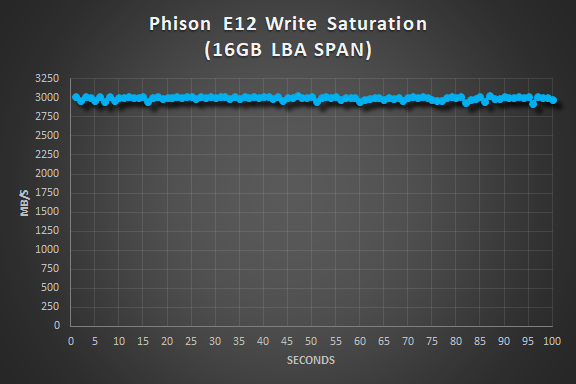WRITE SATURATION
To build upon our real world write test we also look to see where the write speeds level off. If SLC caching is being utilized, this test will usually show it. Typically, we use HD Tune, a Hard Disk Utility with many functions from error checking, health testing (S.M.A.R.T.), and of course benchmarking. However, with the E12 controller we weren’t able to see a drop in performance when testing the whole span, thus we went on to utilize Iometer.
Similar to HDTune, we weren’t able to see a decline in write performance when testing a 16GB span of the drive’s LBAs. Because of this, we moved on to write to the entire LBA range, which is a bit harsher.
Finally, we see what we have been looking for. Once the drive’s SLC cache was exhausted the write performance dropped to a respectable 1GB/s. From the chart above it looks like the drive will take a dive after 30GB. Some other file drag n’ drop transferring in Windows verifies the result as well.
REPORT ANALYSIS AND FINAL THOUGHTS
The Phison E12 is a marked improvement over its predecessor, the E7. We were able to extract sequential read speeds of over 3.4GB/s and sequential write speeds of over 3.1GB/s in testing. As well, it performed admirably in PCMark 8, both the standard and extended tests. With an average bandwidth of 644MB/s in our standard run, it outperformed most current NVMe drives, although the Samsung Pro models still are top dog. During the PCMark 8 extended run, the E12 displayed some very good consistency and much better performance in heavy workloads than the E7 before it. In AS SSD we were even able to extract over 500K/300K IOPS read/write out of it.
Not only does the Phison E12 offer performance improvements, Phison took note about idle power consumption and how important it is to keep it managed better than they have before. The E12 has greatly improved in that regard. At idle our sample sipped just 84mW on average in its lowest power state. Not only that, but active efficiency has improved over the E7. During our 30GB transfer, our E12 sample ranked as the second most efficient NVMe device we have tested to date. Correlating with the improvement in power consumption, over the course of testing we noticed lower temperatures than we have seen with the previous gen E7 controller, this was especially apparent at idle.
We offer a big thanks to Phison for sending this sample our way so that we could get a close look at their new E12 NVMe controller. Based on our results, this new high-performance PCIe 3.0 x4 NVMe controller is capable of delivering some very promising speeds and should provide customers with a great choice for upcoming SSD options. As the weeks roll by, we are looking forward to seeing any more improvements as we get our hands on some retail products.
 The SSD Review The Worlds Dedicated SSD Education and Review Resource |
The SSD Review The Worlds Dedicated SSD Education and Review Resource | 

